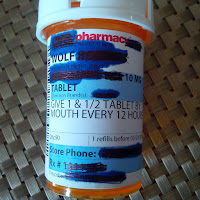Three weeks ago, a friend bought a toy that is pictured below, for Rory, who is a toy breed dog.
He placed it on the kitchen counter, still in the bag supplied by the store he purchased it from, as he continued to carry in the rest of his packages. Eying it for a moment thinking that it looked pretty solid and well made, because of a similarity to a very popular brand toy known for its tough construction, I pushed it toward the back of the counter waiting for my friend to give it to Rory himself.
Rory’s enthusiasm was boundless. She would not give the toy up even to eat her dinner. The attachment to this new toy was not a normal reaction by any means.
On the second day, she began to tear small pieces off of the toy; which I recovered before she had swallowed them. Rory is a tiny dog! I took the toy away from her and placed it back on the counter in the original packaging and then back into the store’s plastic shopping bag, but realized that there is something more and mildly disturbing about Rory’s attachment to this toy that needed to be shared with my readers.
Here’s what is so disturbing. This toy, which I will no longer allow Rory to play with, has been immediately replaced with four other toys that are what I consider to be “safety toys” or at least as safe as I can find. In addition, Rory was allowed to pick them out in the store so that I know she really wanted them. However, Rory continues to jump up and down in front of the counter where I placed the yellow toy shown above. It is now going on four weeks and she still senses that it was on the counter. How? Let me tell you what is “not” the reason. It is not the way the toy looks. It is not the way the toy feels. It is not the way the toy sounds. It is not the way the toy rolls or bounces. It is not anything except “how the toy SMELLS”, and possibly how it tastes, but I couldn’t tell you that.
So, what is embedded in the material of that toy to make the smell so powerful and attractive to a dog that they literally cannot let go of it? How safe could the chemical producing the intense and enticing odor possibly be? BTW, further investigation of the package revealed that this toy was not manufactured in the USA.
Please monitor all toys and chewable items your dog plays with. If their behavior toward the toy seems unusual, follow your instincts about its possible hazardous material content and replace the toy; because you’re probably right.







